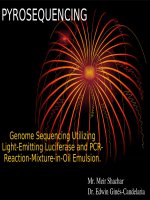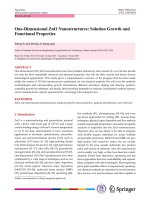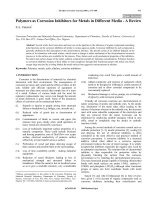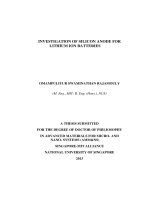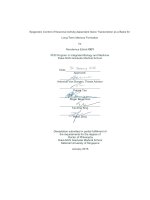Electrospun one dimensional composite materials as durable anode for efficient energy storage
Bạn đang xem bản rút gọn của tài liệu. Xem và tải ngay bản đầy đủ của tài liệu tại đây (5.41 MB, 192 trang )
1
ELECTROSPUN ONE DIMENSIONAL COMPOSITE
MATERIALS AS DURABLE ANODE FOR EFFICIENT
ENERGY STORAGE
ZHANG XIANG
A THESIS SUBMITTED
FOR THE DEGREE OF DOCTOR OF PHILOSOPHY
DEPARTMENT OF MECHANICAL ENGINEERING
NATIONAL UNIVERSITY OF SINGAPORE
2014
2
ELECTROSPUN ONE DIMENSIONAL COMPOSITE
MATERIALS AS DURABLE ANODE FOR EFFICIENT
ENERGY STORAGE
ZHANG XIANG
(B.ENG. (Hons.), Beijing Institute of Technology; M. Sc.,
National University of Singapore)
A THESIS SUBMITTED
FOR THE DEGREE OF DOCTOR OF PHILOSOPHY
DEPARTMENT OF MECHANICAL ENGINEERING
NATIONAL UNIVERSITY OF SINGAPORE
2014
i
i
ACKNOWLEDGEMENT
It has truly been a memorable journey for me to be a member of Center for
Nanofibers & Nanotechnology and deliver my own thinking to complete the research
work here. I would like to take this opportunity to express my gratitude to those who
have been helping and supporting me along the way.
First of all, I would like to express my deepest appreciation and sincerest gratitude
to my supervisor, Prof. Seeram Ramakrishna for his valuable guidance, continuous
support and encouragement throughout my entire Ph.D study. His perspectives in
scientific research and wise counsel have a profound influence on me. His incredible
patience and unconditional encouragement have provided me with a free and vivid
research environment to try out new things.
I would like to thank Dr T. Velmurugan, Prof. S. Madhavi, Prof. HJ Fan, Dr S.
Shannigrahi for their invaluable advices along my research work. I would also like to
thank Dr V. Aravindan for his fruitful discussion and patient help. And I am grateful to
Dr M.V. Reddy for his guidance on the batteries fabrication and electrochemical
measurements. I appreciate the help of Dr P. Suresh Kumar, J. Sundaramurthy, K.
Thirumal, Kai Dan, Jing Guorui, Wu yongzhi, and all the members in our research
group during my candidature.
Especially, I am grateful to my parents, Sir. Dr Zhang and Dr Lu, for their
unconditional love, encouragement and motivation. I would like to give my special
thanks to my wife for believing in me and giving me the inspiration and moral support
when I was down, it was most required.
ii
TABLE OF CONTENTS
PAGE
Acknowledgement i
Table of Contents ii
Abstract vii
List of publications x
List of Figures xii
List of Tables xix
Chapter 1 Introduction 1
1.1 Lithium ion battery 3
1.1.1 Principles of lithium ion battery 3
1.1.2 Challenges associate with lithium ion battery 7
1.1.3 Issues and limitations in lithium ion battery 8
1.1.4 World market of lithium ion battery 11
1.2 Unique attributes of nanostructured electrode materials 11
1.2.1 Unique advantages of nanostructured electrode for lithium ion battery 13
1.2.2 Disadvantages of nanostructured electrode for lithium ion battery 17
1.3 Anode materials for lithium ion battery 18
1.3.1 Intercalation-deintercalation reaction based anode mateirals 20
1.3.2 Lithium alloying-dealloying reaction based anode materials 21
iii
1.3.3 Conversion reaction based anode materials 23
1.4 Specific examples of recent developments 24
1.5 Motivation 30
1.6 Scope of the thesis 31
References 34
Chapter 2 Materials synthesis and characterizations analysis 39
2.1 Electrospinning technology to synthesize 1D nanomaterials 39
2.1.1 Principle of electrospinning 39
2.1.2 The Effect of Electrospinning parameters 42
2.1.3 Electrospun 1D nanomaterials 44
2.2 Materials characterization techniques 45
2.2.1 Powder X-ray Diffraction (XRD) 45
2.2.2 Scanning electron microscopy (SEM) 47
2.2.3 Transmission Electron Microscopy (TEM) 49
2.2.4 Brunauer, Emmett, and Teller (BET) 51
2.2.5 Thermal Analysis 55
2.3 Fabrication of Li-ion coin cells 56
2.3.1 Preparation of electrode materials 56
2.3.2 Assembly of coin cells 57
2.4 Electrochemical studies 59
2.4.1 Galvanostatic cycling 59
2.4.2 Cyclic voltammetry 60
iv
2.4.3 Electrochemical Impedance Spectroscopy (EIS) 61
2.4.3.1 Warburg prefactor 63
2.4.3.2 Impedance Analysis 64
2.4.4 Galvanostatic Intermittent Titration Technique (GITT) 67
References 68
Chapter 3 Formation of TiO
2
hollow nanofibers by co-axial electrospinning and its superior
lithium storage capability in full-cell assembly with olivine phosphate 70
3.1 Introduction 71
3.2 Experimental section 73
3.2.1 Synthesis of hollow nanofibers 73
3.2.2 Materials Characterizations 74
3.2.3 Fabrication of TiO
2
Hollow Nanofibers Based Lithium Ion Batteries and Electrochemical
Measurements 74
3.3 Result and discussion 75
3.3.1 Crystal structure and morphology characterizations 75
3.3.2 Electrochemical Performance of TiO
2
Hollow Nanofibers 80
3.3.3 The Effect of Post-annealing Temperature of TiO
2
Hollow Nanofibers 94
3.4 Conclusions 98
References 99
Chapter 4 Electrospun TiO
2
-graphene composite nanofibers as highly durable insertion
anode for lithium-ion batteries 102
4.1 Introduction 103
v
4.2 Experimental 105
4.2.1 Synthesis of graphene 105
4.2.2 Preparation of titanium dioxide-graphene composite nanofibers 106
4.2.3 Characterizations 107
4.2.4 Fabrication of TiO
2
-graphene Composite Nanofibers Based Lithium Ion Batteries and
Electrochemical Measurements 107
4.3 Results and discussion 108
4.3.1 Crystal structure and morphology characterizations 108
4.3.2 Electrochemical Performance of TiO
2
-graphene composite nanofibers 116
4.3.3 The Effect of graphene weight percentage in TiO
2
–graphene composite nanofibers 125
4.4 Conclusions 128
References 129
Chapter 5 Electrospun Fe
2
O
3
-carbon Composite Nanofibers as Durable Anode Materials for
Lithium Ion Batteries 132
5.1 Introduction 133
5.2 Experimental 135
5.2.1 Synthesis of Fe
2
O
3
-C composite nanofibers 135
5.2.2Characterization 136
5.2.3Fabrication of Fe
2
O
3
-C Composite Nanofibers Based Lithium Ion Batteries and
Electrochemical Measurements 137
5.3 Results and discussions 138
5.3.1 Crystal structure and morphology characterizations 138
vi
5.3.2 Electrochemical Performance of Fe
2
O
3
-C composite nanofibers 143
5.3.3 The Effect of Fe
2
O
3
and Carbon ratio in composite nanofibers 149
5.4 Conclusions 152
References 152
Chapter 6 Conclusions 156
6.1 Summary 156
6.2 Remaining Challenges 168
6.3 Opportunities and new directions 168
References 170
vii
Abstract
There is a growing demand to develop more efficient and cost effective energy
storage systems with high energy density, stable output and longer life span due to the
rapid depletion of fossil fuels. Among the currently available energy storage systems,
rechargeable lithium ion batteries (LIBs) are considered as the most promising
candidates for the applications such as electric vehicles (EVs) and hybrid electric
vehicles (HEVs). In LIBs configuration, developing nanostructures is a primary and
promising strategy to improve the performance, as nanostructures have short Li ions
diffusion length, high electrolyte/electrode contact area and unique chemical and
physical properties over their bulk counterparts.
Commercial LIBs usually use LiCoO
2
as the positive electrode and graphite as the
negative electrode. Graphite can form LiC
6
compound during lithiation and has a
Li-storage capability of 372 mA h g
-1
, which poses a storage limitation for
high-energy applications. Besides the capacity limitation, graphite anode also faces
severe safety problems of lithium plating during high current operation. One solution
to overcome this problem is to develop other LIB anode materials. Binary metal
oxides emerge as one choice serving as the promising LIB anode alternative, in view
of their high theoretical energy capacity vs. graphite, earth abundance and low cost.
Pure Fe
2
O
3
has a high theoretical capacity up to 1007 mA h g
-1
, which is two times
higher than that of graphite.
The primary goal of this project is to better understand the fundamentals of novel
nanostructured composite materials designs, and then thoroughly investigate their
viii
structure, morphological and basic properties (e.g. crystal structures, crystal size,
morphological properties, specific surface area and composition content) during
lithium ion insertion and extraction process. With the knowledge of the relationship
between structure, properties and electrochemical performance, the LIBs can be more
rationally designed.
Firstly, TiO
2
hollow nanofibers were synthesized by co-axial electrospinning and
employed as anode in half-cell (Li/TiO
2
) and full-cell assembly with olivine
phosphate (LiFePO
4
/TiO
2
) to evaluate the battery characteristics. These one
dimensional (1D) hollow porous nanofibers are found attractive on virtue of their
unique structure, chemical stability and high specific surface area, which may benefit
of higher flux of lithium ion across the electrode/electrolyte interface leads to the
facile diffusion of cations. Another approach to improve the Li-ion insertion
efficiency of titania is to fabricate composite nanostructured electrodes, which
interconnect titania with an electron conducting material (such as graphene) that
provides a facile electron pathway. It is of significant interest to fabricate electrospun
TiO
2
-Graphene (TiO
2
-G) nanofibers. Promising high rate lithium intercalation
behavior was exhibited by TiO
2
-Graphene nanofibers as compared to the pristine
demonstrating their potential as a prospective anode for high performance LIB
applications. Lastly the Fe
2
O
3
-carbon hybrid ultralong nanofibers were prepared by
the well-established electrospinning technique. The synthesized Fe
2
O
3
-carbon
composite nanofibers are used as the Li-ion battery anode and dramatical
enhancement in cyclic stability and reversible specific capacity can be achieved. The
ix
composite structure of Fe
2
O
3
nanocrystal highly distributed in carbon nanofibers
matrix has the following advantages: The carbon matrix prevents the pulverization
and aggregation of the Fe
2
O
3
nanoparticles, accommodates the large volume change
of Fe
2
O
3
particles during cycling, improves the electronic conductivity and electrical
contact with the active materials; the one dimensional characteristics of the
nanocomposite provide a good mechanical integrity of the electrode.
To conclude, the electrospun one dimensional nanofibers with attractive unique
structure, chemical stability and high specific surface area help to gain the benefits of
higher flux of Li ions across the electrode/electrolyte interface, leading to the facile
diffusion of Li ions. With the knowledge of the advantages of the unique structure of
nanofibers, hollow TiO
2
was fabricated and showed good electrochemical
performance. Interconnecting TiO
2
nanofibers with an electron conducting material
(graphene) would help to further enhance the Li-ion insertion efficiency. The unique
structure of Fe
2
O
3
/C nanofibers by dispersing Fe
2
O
3
nanoparticles into the carbon
matrix prevents the pulverization and aggregation of the Fe
2
O
3
nanoparticles,
accommodates the large volume change of Fe
2
O
3
nanoparticles during cycling, and
improves the electronic conductivity and electrical contact with the active materials.
The one dimensional characteristics of the nanocomposite provide a good mechanical
integrity of the electrode, and it was showed to be a good candidate for the electrode
materials. Electrospinning is proved to be a convenient and scalable technique to
pattern 1D nanomaterials electrode for LIBs.
x
LIST OF PUBLICATION
Journal Papers
1. Zhang, X.; Thavasi, V.; Mhaisalkar, S. G.; Ramakrishna, S., Novel hollow
mesoporous 1D TiO2 nanofibers as photovoltaic and photocatalytic materials.
Nanoscale 2012, 4, 1707-1716. (IF 6.2)
2. Zhang, X.; Su, A. D;.Rinaldi, A.; Nguyen, S. T.; Liu, H.; Lei, Z.; Lu, L.; Duong,
H. M., Hierarchical porous nickel oxide–carbon nanotubes as advanced
pseudocapacitor materials for supercapacitors. Chem. Phys. Lett. 2013, 561–562,
68-73. (IF 2.1)
3. Zhang, X.; Suresh Kumar, P.; Aravindan, V.; Liu, H. H.; Sundaramurthy, J.;
Mhaisalkar, S. G.; Duong, H. M.; Ramakrishna, S.; Madhavi, S., Electrospun TiO2–
Graphene Composite Nanofibers as a Highly Durable Insertion Anode for Lithium Ion
Batteries. The Journal of Physical Chemistry C 2012, 116, 14780-14788. (highlighted
in Graphene Times. IF 4.8)
4. Zhang, X.; Aravindan, V.; Kumar, P. S.; Liu, H.; Sundaramurthy, J.; Ramakrishna,
S.; Madhavi, S., Synthesis of TiO2 hollow nanofibers by co-axial electrospinning and
its superior lithium storage capability in full-cell assembly with olivine phosphate.
Nanoscale 2013, 5, 5973-5980. (IF 6.2)
5. Zhang, X.; Liu, H.; Petnikota, S.; Ramakrishna, S.; Fan, H. J., Electrospun
Fe2O3-carbon composite nanofibers as durable anode materials for lithium ion
batteries. J. Mater. Chem. A. 2014, 2, 10835-10841. (IF 6.1)
6. Zhang, X. Liu, H. Ramakrishna, S.; Fan, H. J.,et al. Conducting polymer coated
Co3O4 nanowalls as Durable Anode Materials for Lithium Ion Batteries. (Energy &
Environmental Sci, under review)
7. Zhang, X. Rajaraman, B. Liu, H. Ramakrishna, S.; Graphene's Potential in
Materials Science and Engineering. RSC Advances, DOI: 10.1039/C4RA02817A.
8. Kumar, P. S.; Sundaramurthy, J.; Zhang, X.; Mangalaraj, D.; Thavasi, V.;
Ramakrishna, S., Superhydrophobic and antireflecting behavior of densely packed
and size controlled ZnO nanorods. J. Alloys Compd. 2013, 553, 375-382. (IF 2.4)
xi
Conferences papers
1. Electrospun Hollow Mesoporous TiO2 Nanofibers with Larger Surface Area as
Solar Energy Harvester. ICMAT 2011-Reg-2996.
2. Electrospun Graphene-TiO2 Nanocomposite Fiber Mats for High Efficient
Electron Conductor in Photovoltaic Devices. 2012 APS (American Physics
Society).
3. Electrospun TiO2-graphene nanofibers as highly durable anode for lithium
ion batteries. MRS Boston 2013
xii
LIST OF FIGURES
Figure 1-1 Illustration of the charging-discharging process involved in a lithium ion
battery cell consisting of layered LiCoO
2
as cathode and graphite as anode.
Figure 1-2 Schematic diagram of thermodynamic potential window in LIBs.
Figure 1-3 Global lithium ion battery market revenue forecast.
Figure 1-4 Schematic illustration of 3D porous SiNP/conductive polymer hydrogel
composite electrodes.
Figure 1-5 Schematic of the fabrication process for double walled Si nanotubes
(DWSiNTs); SEM and TEM of DWSiNTs.
Figure 1-6 Schematic of the carbon coated LiFePO
4
and Li
4
Ti
5
O
12
full cell battery.
Figure 1-7 Assembly of Si-coated carbon black particles nanocomposite granule
formation.
Figure 1-8 Growth of Self-Assembled TiO
2
-Functionlized Graphene Nanosheets
Hybrid Nanostructures.
Figure 2-1 Electrospinning setup and controllable electrospinning process parameters
Figure 2-2 The coulombic force and surface tension at the needle of a electrospinning
droplet
Figure 2-3 The Taylor cone of electrospinning process
Figure 2-4 Bragg condition for an incident plane wave of wavelength λ, inclined at
angle θ, illuminating a crystal structure with d
hkl
spacing.
Figure 2-5 The different types of adsorption isotherms are determined by the pore
size and surface characterizations of the material.
xiii
Figure 2-6 (a) Schematic diagram of cell assembly; (b) photograph of 2016 type coin
cells and (c) photograph of soft packed full cells
Figure 2-7 Example of EIS spectra with the four different frequency ranges
Figure 2-8 Model I and model II used to fit EIS.
Figure 3-1 (a) Schematic representation of the synthesis of TiO
2
hollow fibers by
co-axial electrospinning and (b) magnified view of the formation of core-shell
nanofibers Taylor cones. (i) Photo image of elecrospinning setup.
Figure 3-2 (a) FE-SEM image of as-spun core shell PEO-PVP/TiO
2
nanofiber and
corresponding inset TEM image shows the single as-spun core-shell (PEO-PVP/TiO
2
)
nanofiber, (b) FE-SEM image of TiO
2
hollow nanofiber after calcination and inset
images corresponds to magnified view of TiO
2
hollow nanofiber, (c) TEM image of a
bundle and individual (Inset images with high magnification) TiO
2
hollow nanofiber
after calcinating, (d) HR-TEM image of the anatase TiO
2
hollowfibers, (e) SAED
pattern of TiO
2
hollow fibers, (f) Rietveld refined X-ray diffraction pattern of TiO
2
hollow nanofibers after calcination in air.
Figure 3-3 Cyclic voltammogram of Li/TiO
2
hollow nanofibers cells cycled between
1-3 V at scan rate of 0.1 mV s
–1
, in which metallic lithium serves as both counter and
reference electrode.
Figure 3-4 (a) Initial charge-discharge curves of Li/TiO
2
hollow nanofibers cell
cycled between 1-3 V at current density of 100 mA g
–1
in room temperature, and (b)
Plot of capacity vs. cycle number
xiv
Figure 3-5 (a) Specific capacity of TiO
2
hollow nanofibers in half-cell configuration
between 1-3 V vs. Li at various current densities in ambient temperature conditions.
Plot of capacity vs. cycle number. (b) Galvanostatic cycling performance of
electrospun anatase nanofibers prepared through two different electrospinning
techniques such as conventional single needle procedure and co-axial electrospinning
technique.
Figure 3-6 (a) Cyclic voltammogram of Li/electrospun TiO
2
hollow fibers cells
recorded at various scan rates between 1-3 V vs. Li in ambient temperature conditions
and (b) Relationship between the peak current density and the square root of scan rate
in anodic processes.
Figure 3-7 Cyclic voltammogram of Li/LiFePO
4
cells cycled between 2.5-4 V at scan
rate of 0.1 mV s
–1
.
Figure 3-8 (a) Normalized charge-discharge curves of Li/LiFePO
4
cells cycled
between 2.5-4 V at current density of 100 mA g
–1
in room temperature, and (b)
cycling performance of charge/discharge capacity vs. cycle number.
Figure 3-9 Cyclic voltammogram of LiFePO
4
/TiO
2
hollow nanofibers cells (Pink
line) cycled between 0.9-2.5 V at scan rate of 0.1 mV s
–1
;The green line and orange
line indicate the Cyclic voltammogram profiles of Li/TiO
2
hollow nanofibers and
Li/LiFePO
4
cells, respectively.
Figure 3-10 (a) Typical galvanostatic charge-discharge curves of LiFePO
4
/TiO
2
hollow nanofibers cells cycled between 0.9-2.5 V at current density of 100 mA g
–1
in
room temperature, and (b) Plot of discharge capacity vs. cycle number of
xv
LiFePO
4
/TiO
2
hollow nanofibers cells with columbic efficiency, in which red square
and pink circle corresponds to discharge capacity and columbic efficiency,
respectively.
Figure 3-11 (a) Galvanostatic charge–discharge curves of LiFePO
4
/TiO
2
cells cycled
between 0.9 and 2.5 V at various current densities from 0.05-1 A g
-1
in room
temperature, and (b) plot of discharge capacity vs. cycle number.
Figure 3-12 Specific capacity of co-axial electrospinning TiO
2
nanofibers with
different post-annealing temperature at different charge/discharge rate
Figure 3-13 XRD patterns of co-axial electrospinning TiO
2
nanofibers with different
post-annealing temperature
Figure 4-1 (a) FE-SEM image of a bundle of as-spun TiO
2
-graphene composite
nanofiber mats. Inset is the optical image of as-prepared sol-gel solution before
electrospinning, (b) FE-SEM image of a bundle of TiO
2
-graphene composite
nanofiber mats sintered at 450
o
C in Ar atmosphere. Insert is the optical image of
as-electrospun TiO
2
-graphene composite nanofibers before heat treatment. (c)
Magnified FE-SEM image of the surface of TiO
2
-graphene composite nanofibers.
Inset is the optical image of as-electrospun TiO
2
-graphene composite nanofibers after
heat treatment and (d) FE-SEM image of the tip of TiO
2
-graphene composite
nanofibers with another magnification
Figure 4-2 (a) EDS spectrum of TiO
2
-graphene composite nanofibers, (b)
Corresponding TEM image of a single TiO
2
-graphene composite nanofiber for
xvi
elemental mapping, (c) Mapping of Carbon, (d) Mapping of Titanium and (e)
Mapping of Oxygen
Figure 4-3 (a) TEM image of a single TiO
2
-graphene composite nanofibers, (b)
Corresponding SAED pattern, (c) and (d) HR-TEM images of TiO
2
-graphene
composite nanofibers (The anatase TiO
2
phase indicated by red line)
Figure 4-4 (a) Powder X-ray diffraction patterns of TiO
2
-graphene composite
nanofibers and (b) Raman spectrum of TiO
2
-graphene composite nanofibers
Figure 4-5 N
2
adsorption and desorption isotherm of bare and TiO
2
-graphene
composite nanofibers and the inset is pore size distribution.
Figure 4-6 Cyclic voltammogram of (a) TiO
2
-graphene composite nanofibers and
(b) TiO
2
bare nanofibers half-cells cycled between 1-3 V at scan rate of 0.1 mV s
–1
,
in which metallic lithium serves as both counter and reference electrode.
Figure 4-7 (a) Initial charge-discharge curves of Li/TiO
2
-graphene composite
nanofibers half-cell cycled between 1-3 V at current density of 33 mA g
–1
in room
temperature, and (b) cycling performance of the Li/TiO
2
-graphene composite
nanofiber cell
Figure 4-8 (a) Initial charge-discharge curves of bare TiO
2
nanofibers and
TiO
2
-graphene composite nanofibers cycled between 1-3 V vs. Li at current density of
150 mA g
–1
and (b) cycling performance and (c) specific capacity with different
current densities.
xvii
Figure 4-9 (a) Initial discharge-charge curves of bare TiO
2
nanofibers, TiO
2
-Graphene
composite nanofibers and TiO
2
-Graphene composite nanoparticles in half-cell
configuration cycled between 1-3 V vs. Li at constant current density of 150 mA g
–1
(b) plot of discharge capacity vs. cycle number
Figure 4-10 Electrochemical impedance spectroscopic traces of TiO
2
-bare nanofibers
and TiO
2
-graphene composite nanofibers.
Figure 4-11 Specific capacity of TiO
2
-graphene composite nanofibers with different
weight percentage of graphene at different charge/discharge rate
Figure 4-12 (a) Impedance measurement of coin cells using the electrode materials of
TiO
2
-graphene composite nanofibers with different weight percentage of graphene; (b)
Specific capacity of TiO
2
-graphene composite nanofibers with different weight
percentage of graphene at 5.4C
Figure 5-1 (a) FESEM image of the as-spun nanofiber mat; (b) The nanofiber mat
after stabilization by annealing at 280
o
C in Air; (c) The Fe
2
O
3
-C composite nanofiber
mat after carbonization at 500
o
C in argon; (d)-(f) Close-up views of Fe
2
O
3
-C
composite nanofibers after calcination at 500
o
C in argon.
Figure 5-2 TEM characterization of the Fe
2
O
3
-C composite nanofibers. (a) Typical
structure of the composite nanofiber; (b) The tip of the composite nanofiber; (c) The
corresponding SAED pattern; (d) HRTEM image of the hematite Fe
2
O
3
crystals; (e)
TEM image of a single Fe
2
O
3
-C composite nanofiber with elements mapping; (f)-(h)
Element mappings of carbon (red), oxygen (blue), and iron (green), respectively.
Figure 5-3 (a) X-ray diffraction patterns and (b) Raman spectrum of the Fe
2
O
3
-C
xviii
composite nanofibers.
Figure 5-4 N
2
adsorption and desorption isotherm of Fe
2
O
3
-C composite nanofibers
Figure 5-5 TEM characterization of the Fe
2
O
3
nanofibers. (a) Typical structure of
Fe
2
O
3
nanofiber; (b) The tip of Fe
2
O
3
nanofiber;
Figure 5-6 Cyclic voltammogram of (a) Fe
2
O
3
-C composite nanofiber and (b) pure
Fe
2
O
3
nanofiber half-cells cycled between 0.005 and 3 V at a scan rate of 0.05 mV s
−1
,
in which metallic lithium serves as both counter and reference electrode.
Figure 5-7 (a) Galvanostatic charge-discharge curves of Fe
2
O
3
-C composite
nanofibers electrode cycled between 0.005 and 3 V (vs. Li/Li
+
) at 0.2 C rate (1 C
=1007 mA g
-1
); (b) Cyclic performance of Fe
2
O
3
-C composite nanofiber and pure
Fe
2
O
3
nanofiber electrodes at 0.2 C rate; (c) Rate capability of Fe
2
O
3
-C composite
nanofiber electrodes at different rates; (d) Nyquist plots of Fe
2
O
3
-C composite
nanofiber and pure Fe
2
O
3
nanofiber electrodes; (e) The equivalent circuit to fit the EIS
spectra.
Figure 5-8 TEM images of the Fe
2
O
3
-C-1 nanofibers (a); Fe
2
O
3
-C-2 nanofibers (b)
and carbon nanofibers (c).
Figure 5-9 (a) Cyclic performance of Fe
2
O
3
-C composite nanofibers and Carbon
nanofibers electrodes at 0.2 C rate (1 C =1007 mA g
-1
); (b) Galvanostatic
charge-discharge curves of Fe
2
O
3
-C composite nanofibers and carbon nanofibers
electrode cycled between 0.005 and 3 V (vs. Li/Li
+
) at 0.2 C rate.
xix
LIST OF TABLES
Table 1-1 Specifications of typical commercial rechargeable batteries
Table 1-2 Specific electrochemical performances of typical material systems
Table 3-1 The specifications of co-axial electrospinning TiO
2
nanofibers with
different post-annealing temperature
Table 4-1 Texture properties of TiO
2
-graphene composite nanofibers and bare TiO
2
nanofibers
Table 4-2 The specifications of TiO
2
-graphene composite nanofibers with different
weight percentage of graphene
Table 5-1 Impedance parameters of Fe
2
O
3
-C composite nanofibers and bare Fe
2
O
3
nanofibers electrodes
Table 5-2 The comparisons of electrochemical performance of Fe
2
O
3
-carbon
nanofibers with different carbon content
1
Chapter 1 Introduction
Nowadays, most of the energy is generated from fossil fuel. However, fossil fuels are
the main cause of global warming and gradually depleting. As a result, more and more
attention was put to develop electrical energy storage system, supplying a clean and
sustainable energy, which could help to lower the dependence on fossil fuel. Because
of the intermittent and cyclic nature of electricity generation from renewable and
sustainable sources (such as solar, wind, and geothermal), energy storage systems are
highly in demand to manage the mismatch between electricity generation and demand.
Varieties of energy storage solutions as chemical, mechanical, and magnetic storage
are being presently developed. Among them, batteries provide the most effective
mean to convert chemical energy to electrical energy and vice-versa by
electrochemical redox reaction. Compared to the conventional nickel-metal hydride
(Ni-MH), nickel-cadmium (Ni-Cd), and lead acid batteries, lithium ion batteries (LIBs)
have attracted the most attention because of the higher volumetric and gravimetric
energy capabilities, which can function as the primary power sources in portable
electronics (mobile phone, laptop, ipad, cordless tool and portable implantable
medical devices). In addition, the self-discharge in LIBs is less than that in
nickel-cadmium (Ni-Cd) and nickel-metal hydride (Ni-MH), leading to less harm
when disposed. LIBs have been widely explored and demonstrated their ability in the
past 10 years to serve as the clean energy transportation system such as electric
vehicles (EVs), hybrid electric vehicles (HEVs) and plug-in hybrid electric vehicles
(PHEVs).
2
The development of Lithium batteries origins back to 1970s when M. S.
Whittingham applied the titanium (IV) sulfide and lithium metal as the electrodes to
fabricate the first lithium battery.
1
The primary lithium batteries with metallic lithium
anodes encounter safety issues. After that, lithium-ion batteries were developed with
both electrodes containing lithium ions. Shortly after, John Goodenough and Koichi
Mizushima demonstrated a rechargeable cell with voltage in the 4 V range
using lithium cobalt oxide (LiCoO
2
) as cathode and lithium metal as anode at Oxford
University in 1972.
2
In 1980s, Rachid Yazami demonstrated the reversibly process of
lithium intercalated in graphite through an electrochemical mechanism using a solid
electrolyte.
3, 4
Since then, graphite developed by R. Yazami served as the most
commonly used anode in commercial lithium ion batteries. In 1985, Akira
Yoshino fabricated a prototype cell using carbonaceous material as anode and lithium
cobalt oxide (LiCoO
2
) as cathode, which is stable in air.
5
By using materials without
metallic lithium, the safety of the batteries can be dramatically improved. The first
commercial Lithium ion battery was introduced by Sony in the 1990s, in which
specialty graphite, and later mesocarbon microbeads (MCMB) of graphite was used as
negative and LiCoO
2
as positive electrode materials, respectively.
3
1.1 Lithium ion battery
1.1.1 Principles of lithium ion battery
Figure 1-1. Illustration of the charging-discharging process involved in a lithium ion
battery cell consisting of layered LiCoO
2
as cathode and graphite as anode.
6
Reprinted
with permission from ref. 6
LIBs are comprised of four mains components: lithium intercalation compounds
(LiCoO
2
) as cathode, graphitic carbon as anode, liquid electrolyte which provides the
medium for transfer of charge between anode and cathode, a separator which prevent
internal short-circuit in the LIBs, and current collectors (Fig 1-1).
7
Energy storage and
supply is done through lithium ions insertion/extraction between anode and cathode.
During discharging, lithium ions are released from the anode to the electrolyte, diffuse
through the electrolyte which is an ion conductor but electrical insulator, and
intercalated into the cathode. Spontaneously, the electrons are moving from the anode

